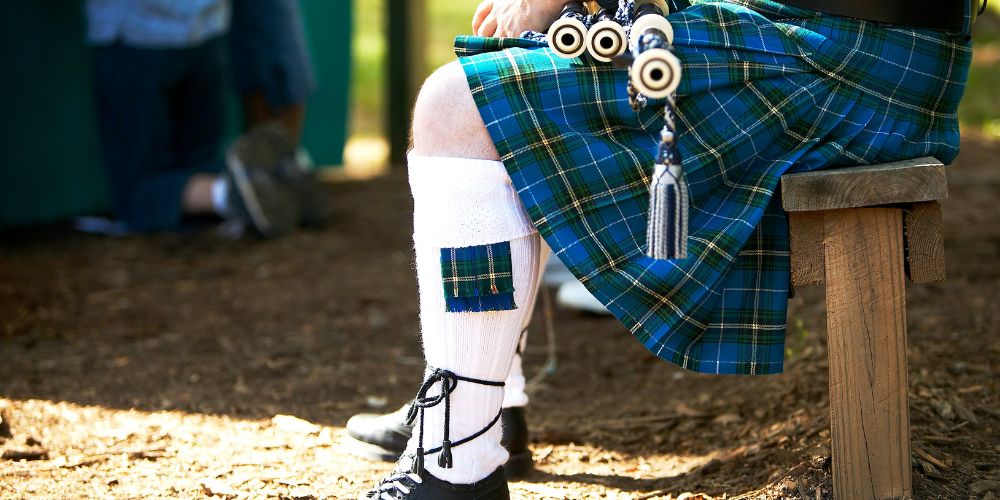Kilts are traditional garments steeped in history, with a significance that stretches beyond mere fashion. To maintain their majestic appeal and ensure longevity, proper care is pivotal. This comprehensive guide will detail how to wash, clean, press, and store Kilts.
Care

Store Your Kilt Properly
Proper storage is the cornerstone of kilt care. When it comes to maintaining your kilt, it all begins with how you store it. Hanging your tartan kilt is essential to preserve the integrity of the pleats. Folded storage can lead to permanent creases that mark the kilt's structure.
Therefore, invest in a purpose-made kilt hanger to ensure your kilt is hung correctly. This prevents sagging and keeps the fabric from becoming misshapen over time. When choosing a spot for storage, opt for a dry, cool area to avert any mold or mildew development.
Protect Your Kilt from Direct Sunlight
Direct sunlight can be your kilt's worst enemy. Prolonged exposure to UV rays can damage and fade the fabric, which is something you definitely want to avoid. If, for some reason, you're compelled to store your utility kilt in a well-lit space, consider using a garment bag or a cloth to shield it from the harmful effects of sunlight. This simple step can go a long way in preserving your kilt's vibrant colors and overall condition.
Protect Your Kilt from Moths
Moths, those tiny, seemingly harmless creatures, pose a silent but significant threat to your kilt. They can wreak havoc on the fabric, leading to holes and fraying. Consider using mothballs or cedar chips to protect your wool kiltfrom these pests.
These natural repellents can deter moths from making your kilt their snack. Additionally, it's essential to routinely inspect your kilt for signs of moth-induced damage. Look for tiny holes or thread fraying and take action promptly to prevent further damage.
Washing
Clean Your Kilt Regularly
Regular cleaning is crucial for your kilt to maintain its best appearance and longevity. However, this doesn't mean you need to wash it after every wear. Instead, the frequency of cleaning should depend on your wear patterns and the exposure of your kilt to dirt, sweat, and potential fabric-damaging substances.
Follow Care Instructions
Always refer to the care label on your kilt or consult the manufacturer's recommendations. Some kilts for men might tolerate machine washing, while others, especially those with delicate fabrics or embellishments, might require professional cleaning. Knowing your kilt's specific care requirements is vital to avoid mishaps during cleaning.
How to Wash Kilts: A Step-by-Step Handwashing Guide
When it's time to clean your kilt, and you've determined that hand washing is the way to go, here's a step-by-step guide to ensure you do it correctly:
Check the care label: Before you start, ensure that your kilt doesn't have unique care prerequisites. This step is crucial to avoid any potential damage during the cleaning process.
Prepare your basin: Fill a basin with cold water and add a touch of mild detergent. The cold water will help prevent any color bleeding or fabric damage.
Soak the kilt: Immerse it in soapy water and gently agitate it with your hands. Allow it to soak for 15-30 minutes. This soaking period helps to loosen dirt and stains, making them easier to remove.
Rinse well: After the soaking period, refresh the basin with cold water and rinse the kilt until the water runs clear. Thorough rinsing is essential to ensure that no detergent residue remains, which can cause fabric damage.
Press out excess water: Once your kilt is rinsed, gently press out the excess water. Avoid wringing the kilt, as this can damage the fabric and pleats.
Dry flat: Lay your kilt on a clean towel to dry. This is the time to reshape the pleats if necessary. Ensure that your kilt dries away from direct sunlight to prevent any potential fading or damage to the fabric.
Storing
Air it out
Storing your kilt properly isn't just about finding the right place but also the right technique. After wearing your kilt, allow it to air out. This is especially crucial if it has been exposed to sweat or high humidity. Giving it some time to breathe can help prevent odors and moisture build-up, which can lead to mold or mildew.
Hang appropriately
When you're ready to store your kilt, ensure you do it right. Utilize a kilt hanger, and make sure it's securely clipped to avoid sagging. Proper hanging maintains the pleats' integrity and ensures the fabric doesn't become misshapen over time. Hanging your kilt is the best way to preserve its form and structure.
Space it out
Finally, when placing your kilt in the wardrobe, ensure it has ample space. Avoid tight spots or overcrowding, as this can lead to creases and damage to the fabric. Giving your kilt room to breathe in your wardrobe will help maintain its pristine condition.
Traveling with Your Kilt
Traveling with your kilt requires special care to ensure it arrives at your destination in the best condition possible. Here are some tips for traveling with your kilt:
Rolling Your Kilt
When packing your kilt for travel, rolling it is preferable to folding. Folding can create creases that are difficult to remove, whereas rolling is more likely to keep your kilt wrinkle-free. It's a simple but effective way to ensure your kilt looks its best when you arrive at your destination.
Consider a Kilt Carrier
For air-bound adventures or longer trips, consider using a kilt carrier. These specialized carriers are designed to protect your kilt and keep it pristine during travel. They typically have compartments for your kilt, sporran, and other kilt accessories, ensuring everything arrives safely.
Sgian Dhu and Airport Security
If you're traveling with a sgian dhu, the traditional Scottish knife often worn with kilts, be aware of airport security measures. Check with your airline and the specific airport security guidelines to ensure your sgian dhu complies with the rules. It may need to be packed in your checked luggage to avoid any issues at security checkpoints.
Pressing
Pressing your kilt is the final step to restore its crisp appearance after cleaning. Here's a guide on how to do it correctly:
Preparation
Start by donning your kilt and observing the pleats in a mirror. This step is essential to ensure that the pleats are correctly aligned and that your kilt will look its best once pressed.
Lay it Down
Lay your kilt on an ironing table or a flat surface. It's essential to have a flat, even surface to work on to achieve the best results.
Moisten
Slightly dampen the area you intend to press. Using a spray bottle with water is a good way to achieve this. The slight dampening of the fabric will make shaping and pressing the pleats easier.
Position the Pleats
Before you start pressing, adjust each pleat to its original position. This step is crucial to ensure the pleats look sharp and well-defined once the kilt is pressed. Take your time to get them just right.
Press
Now, it's time to start pressing. Carefully press down on the dampened fabric using a steam iron with a pressing cloth. Pressing without sliding the iron is essential, as this can damage the fabric or misalign the pleats. The pressing cloth helps protect the kilt's fabric from direct contact with the hot iron, preventing any burns or shiny spots.
Cool
Once you've finished pressing, allow your kilt to cool without any disturbances. This cooling process helps set the pleats and ensures that they maintain their shape. Being patient during this step is crucial to achieve the best results.
FAQs:
How often should I clean my kilt?
Cleaning frequency depends on wear patterns and exposure to dirt. Generally, kilts need cleaning after several wears, but not after every use.
Can I machine wash my kilt?
It depends on the kilt's material. Some are machine washable, but delicate ones may require professional cleaning for safety.
What's the best way to remove wrinkles from a kilt?
To remove wrinkles, hang the kilt properly or use a steamer. Never directly iron the fabric, as it can damage pleats.
How do I protect my kilt from moths and other pests?
Use natural repellents like mothballs or cedar chips and regularly inspect for damage to prevent moth-related issues.
Is it safe to iron a kilt, and if so, how?
Iron your kilt using a steam iron and a pressing cloth to protect the fabric. Be cautious to avoid burns or misaligned pleats.
What are the best practices for traveling with a kilt?
Roll your kilt to prevent wrinkles when traveling. Consider a kilt carrier for long trips and check airline security guidelines for traditional accessories.
Conclusion
Caring for your kilt is a labor of love, but it's a labor that pays off in the form of a lasting emblem of tradition and style. From correct storage techniques and protection from the elements to meticulous cleaning and careful pressing, every step is vital to ensure your kilt remains pristine for generations to come.
Proper storage, such as hanging your kilt with the right hanger in a dry, cool spot, protects its structure and prevents sagging. Protecting your kilt from direct sunlight and moths is essential to maintain its color and fabric integrity. Regular cleaning, following care instructions, and hand washing when necessary will keep your kilt looking its best.
Rolling it and using a kilt carrier can help preserve its condition when traveling with your kilt. Be sure to check airport security guidelines when carrying traditional accessories like the sgian dhu.
Finally, the art of pressing your kilt is the finishing touch that restores its crisp appearance. By following these professional tips and giving your kilt the care it deserves, you ensure it retains its grandeur and elegance for years. Your kilt is more than a garment; it's a symbol of tradition, and with the right care, it can be passed down through generations as a testament to your heritage and style.














